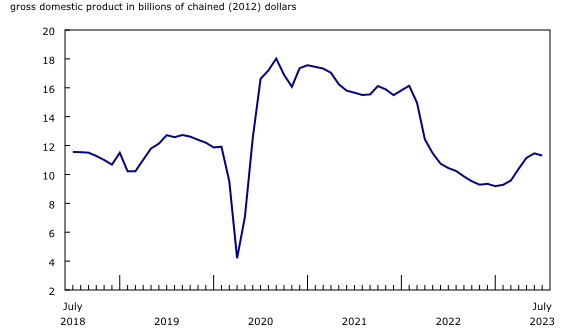Real gross domestic product (GDP) was essentially unchanged in July, following a 0.2% decline in June. Services-producing industries edged up 0.1% in the month, while goods-producing industries contracted 0.3%. Overall, 9 of 20 industrial sectors posted increases.
Chart 1
Real gross domestic product essentially unchanged in July

Manufacturing declines for a second consecutive month
The manufacturing sector (-1.5%) had the largest negative contribution in July, its largest since April 2021. This was the second consecutive monthly contraction for the sector. The July 2023 decline largely stems from lower inventory formation.
Non-durable manufacturing contracted for the third time in the last four months in July, as five of nine subsectors were down, with plastics and rubber products (-8.1%) and chemical manufacturing (-3.6%) contributing the most to the decrease. The port strike in British Columbia impacted the chemical manufacturing subsector the most.
Durable manufacturing, down for the fourth time in five months in July, contracted the most since July 2021 due to broad-based declines across the subsectors.
Chart 2
Manufacturing sector declines in July

Certain sectors impacted by wildfires in June bounce back in July
After experiencing declines in June due to forest fires, both mining and quarrying (except oil and gas) and accommodation and food services grew in July.
Mining and quarrying (except oil and gas) increased 4.2% in July, more than offsetting June’s decline. Metal ore mining (+4.1%) and non-metallic mineral mining and quarrying (+7.1%) led the increase, whereas setbacks in coal mining (-2.3%) tempered growth. Metal ore mining growth was led by a 25.6% jump in the iron ore mining subsector as production increased following the impact of wildfires in June. Non-metallic mineral mining and quarrying was driven by an increase in potash mining.
Accommodation and food services rose 2.3% in July with both subsectors increasing, leading to its largest growth rate since January 2023.
The food services and drinking places subsector was the largest driver of growth in the accommodation and food services sector, rising 2.4% in July, which more than offset the decline recorded the previous month.
Accommodation services expanded 2.6% in July as traveller accommodation and recreational vehicle (RV) parks, camping grounds and rooming and boarding houses rose. Traveller accommodation posted a second consecutive monthly increase. RV parks, recreational camps and rooming and boarding houses expanded for the first time in three months in July, offsetting part of the declines recorded in the previous two months, as the risks associated with forest fires continued to limit activity in many parts of the country.
Transportation and warehousing down
The transportation and warehousing sector contracted 0.2% in July as 6 of 10 subsectors were down.
Air transportation (-2.1%) was the largest contributor to the sector’s decline in July, contracting for the second consecutive month. Bad weather in the eastern United States over the Canada Day long weekend caused multiple delays and flight cancellations on both sides of the border.
Water transportation contracted 3.4% in July as closure of more than 30 British Columbia ports, including Canada’s busiest—the Port of Vancouver—impacted the amount of trade that could move by ships. Significant declines in both imports from and exports to countries other than the United States impacted the sector, in particular a decrease in goods coming from China.
Despite the British Columbia port strike and inclement weather affecting a rail line in Nova Scotia, rail transportation rose 1.1% in July.
Grain terminals in British Columbia remained unaffected by the port strike, so canola and wheat were able to be exported, with canola more than doubling in July, resulting in higher carloadings of the commodities. Intermodal carloadings were the largest detractor to growth as the port strike limited the number of containers moving in and out of ports. Rebounds in iron ore mining, after a significant decline in June, helped push up iron ore carloadings in July as various mining companies were able to increase their production.
Support activities for transportation fell 0.5% in July on lower support activities for freight, water and air transportation.
Energy sector increases in large part due to higher natural gas extraction
Oil and gas extraction rose 1.5% in July, up for the sixth time in the last seven months, as all industries were up in the month. Oil and gas extraction (except oil sands) expanded 2.4% in July, led by the continued ramp up of natural gas extraction in Western Canada, following a period of wildfires-induced contraction.
Oil sands extraction grew 0.8% in July. The growth was largely a result of higher synthetic crude oil production in Alberta as several facilities began ramping up production following a period of maintenance in May and June.
Pipeline transportation declined 1.2% in July, partly offsetting an expansion of 2.3% in June, as lower crude oil and other pipeline transportation (-2.2%) contributed the most to the decline.
Petroleum refineries decreased 1.9% in July, down for a second month in a row, as lower production of motor gasoline, aviation fuel and petrochemical feedstock contributed to the decline.
Finance and insurance increases on buying activity
Finance and insurance rose for the third consecutive month, up 0.3% in July. Buying activity on the equity market in July helped the Toronto Stock Exchange (TSX) increase 2.3%. Major buying of resource-related sectors was the driver of the gain which in turn boosted financial investment services, funds and other financial vehicles (+1.9%).
Real estate and rental and leasing continues to grow
Real estate and rental and leasing edged up 0.1% in July, continuing growth since November 2022.
Offsetting some of the growth were offices of real estate agents and brokers and activities related to real estate (-1.3%), which fell for the first time in six months in July 2023. Interest rate hikes in both June and July may have deterred some buyers in the month. Despite increasing activity in the majority of markets in July, declines in the Greater Toronto Area along with the Fraser Valley more than offset those increases.
Chart 3
Activity at the offices of real estate agents and brokers falls in July

Legal services, which derive much of their activity from real estate transactions, contracted 0.4% in July.
Professional, scientific and technical services contract for the first time in eight months
The majority of industries that comprise the professional, scientific and technical services sector were down in July, resulting in the overall decrease in the sector (-0.2%). Computer systems design and related services (-0.5%) and accounting, tax preparation, bookkeeping and payroll services (-0.4%) contributed the most to the decline.
Advance estimate for real gross domestic product for August 2023
Advance information indicates that real GDP edged up 0.1% in August. Increases in the wholesale trade and finance and insurance sectors were partly offset by decreases in the retail trade and oil and gas extraction sectors. Owing to its preliminary nature, these estimates will be updated on October 31, 2023, with the release of the official GDP by industry data for August.






